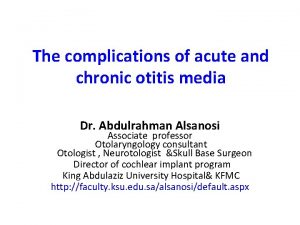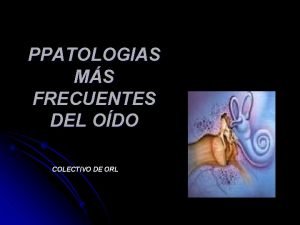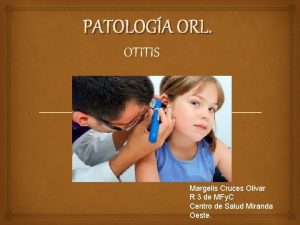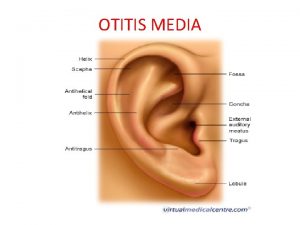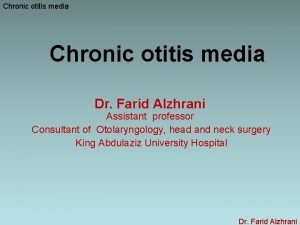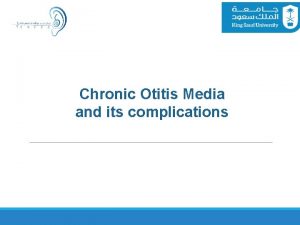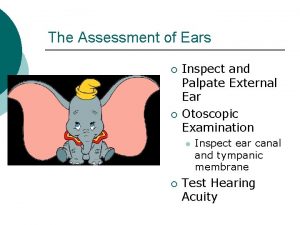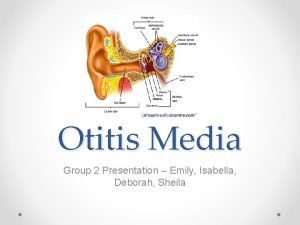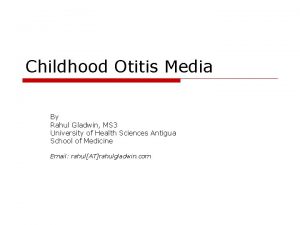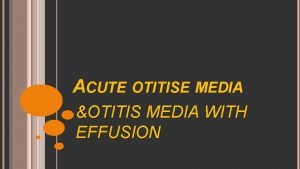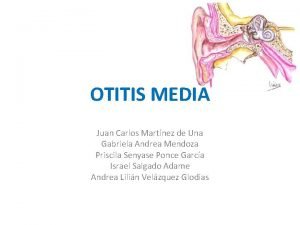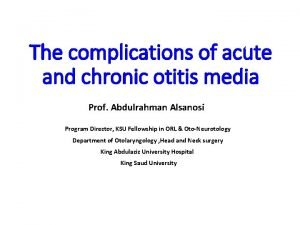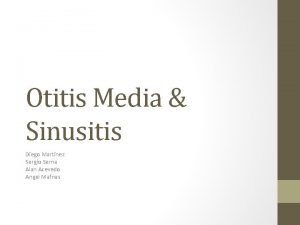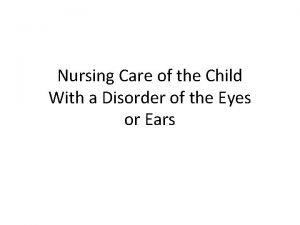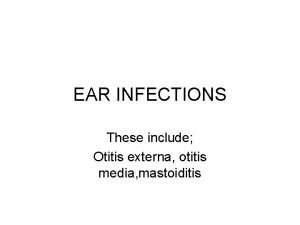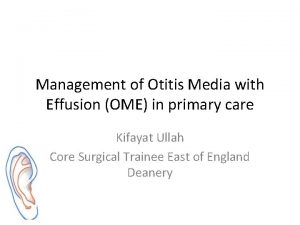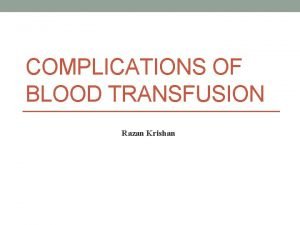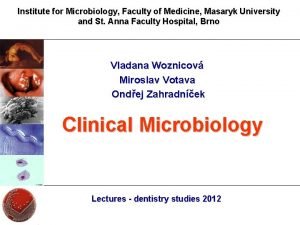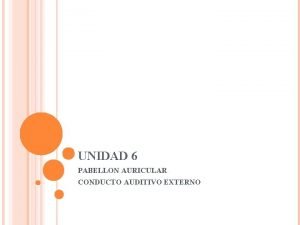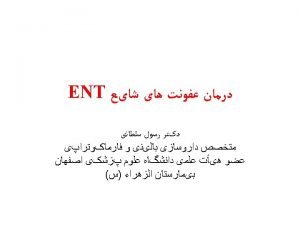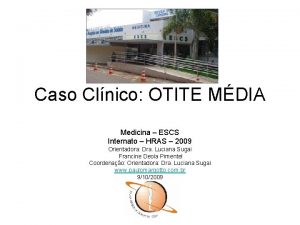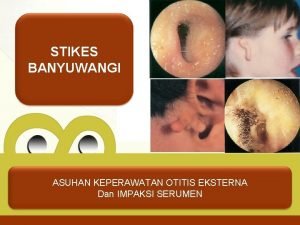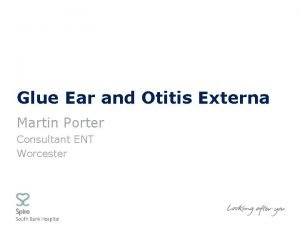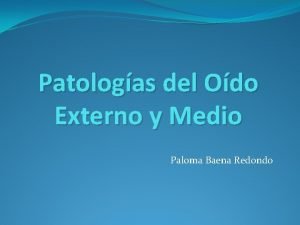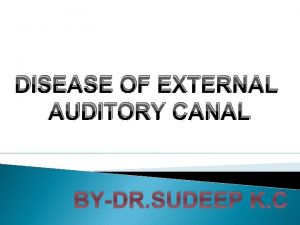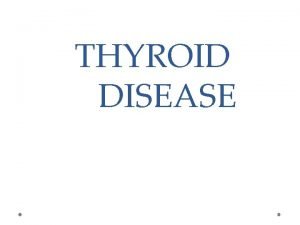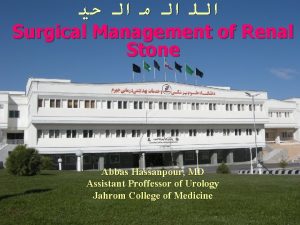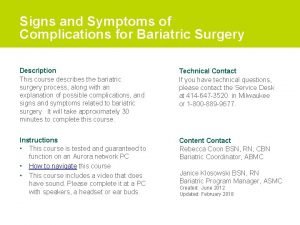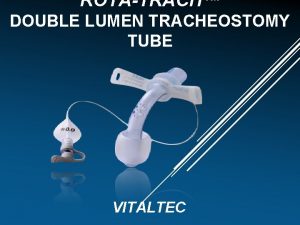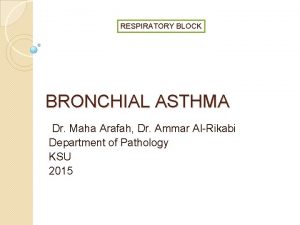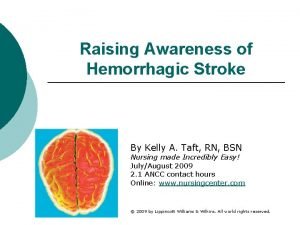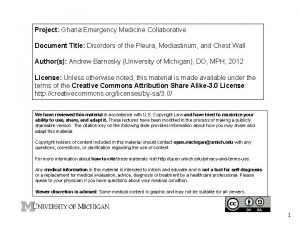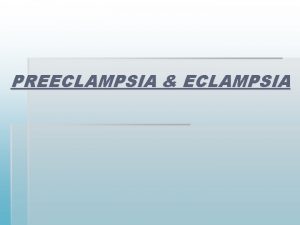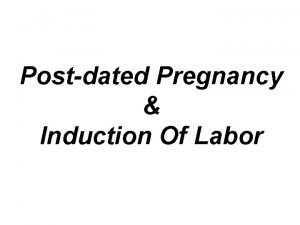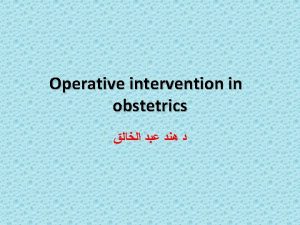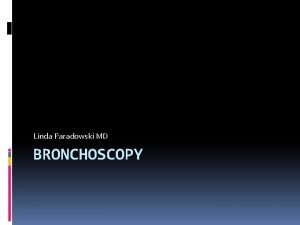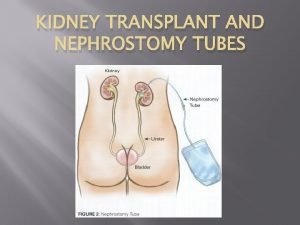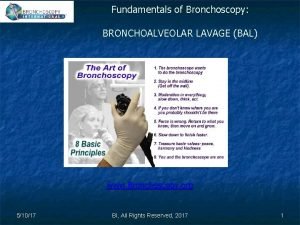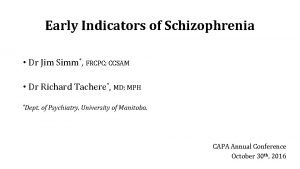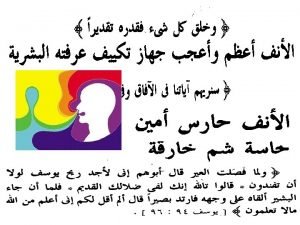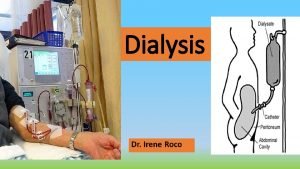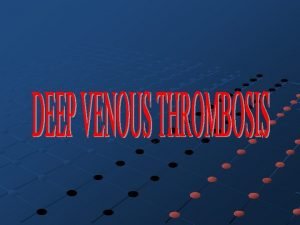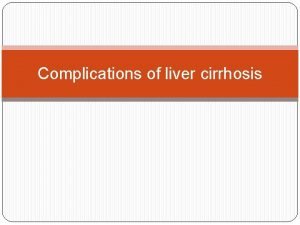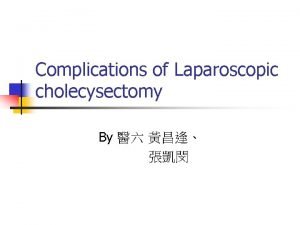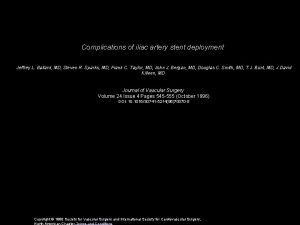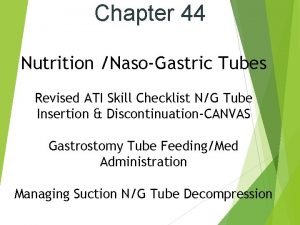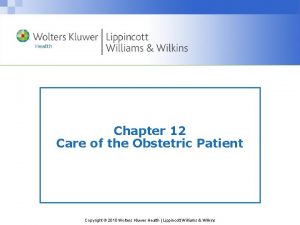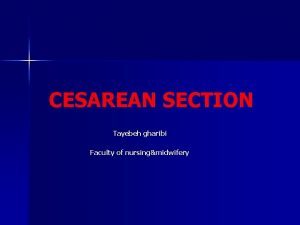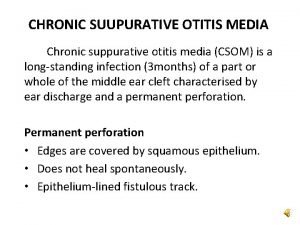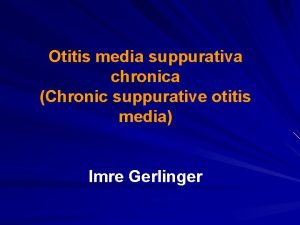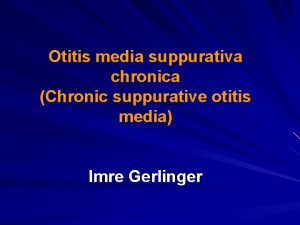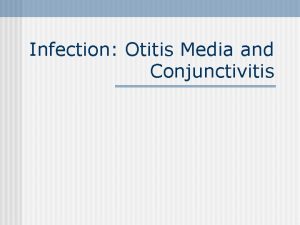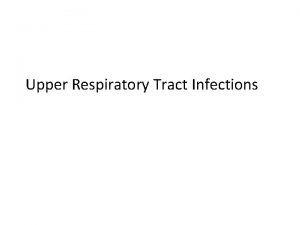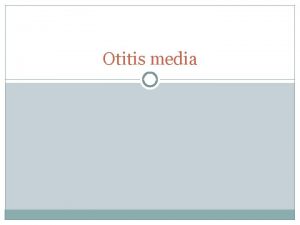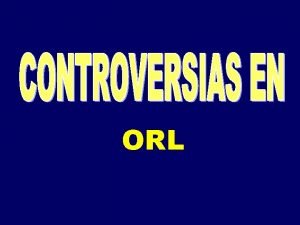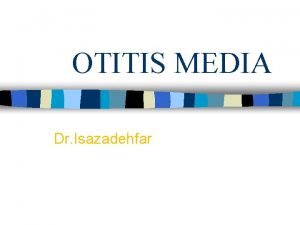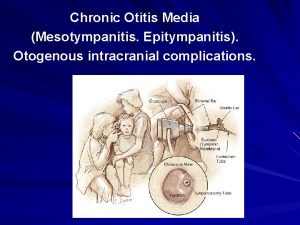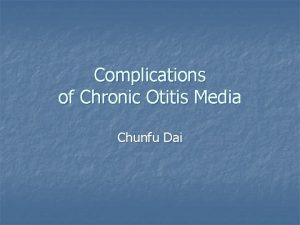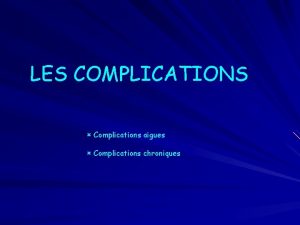Chronic Otitis Media and its complications Chronic Otitis



































































- Slides: 67

Chronic Otitis Media and its complications

Chronic Otitis Media

Definition Inflammation of the middle ear. May also involve inflammation of mastoid.

Classifications Chronic Non Suppurative Otitis Media 1. Otitis media with effusion “OME” 2. Adhesive otitis media Chronic Suppurative Otitis Media “CSOM” 1. Tubotympanic (Safe) 2. Atticoantral (Unsafe)

Acute Otitis media Persistent Effusion Resolution Acute perforation +Otitis Media Chronic Supportive Otitis Media Safe Unsafe Resolution Healing

Chronic Non Suppurative Otitis Media

Otitis Media with Effusion (Chronic non-suppurative Otitis Media) Middle ear filled with serous or mucoid fluid No purulence Often present after acute otitis media is treated appropriately with antibiotics Most will clear within 3 months

Otitis Media with Effusion (Chronic non-suppurative Otitis Media) Etiology : Bacteria Strep pnuemonia Moraxella cat. Haemophilus influ. Virus RSV Rhinovirus Parainfluenza virus Influenza virus

Otitis Media with Effusion (Chronic non-suppurative Otitis Media) Diagnosis: History. Clinical Examination. Tuning fork tests. Audiological assessment.

Otitis Media with Effusion (Chronic non-suppurative Otitis Media) Tuning fork test Weber and Rinne test Audiological assessment: 1. Tympanometry

Otitis Media with Effusion (Chronic non-suppurative Otitis Media) • Audiological assessment: 2. B-Pure tone audiogram

Otitis Media with Effusion (Chronic non-suppurative Otitis Media) v Medical Treatment of OME : ◦ Observation – many European countries wait 6 -9 months prior to placement of ear tubes. ◦ Antibiotics ◦ Meta-analysis shows beneficial short-term resolution of OME ◦ Audiogram at 3 months with persistent effusion to determine impact on hearing

Otitis Media with Effusion (Chronic non-suppurative Otitis Media) v. Surgical treatment (Tympanostomy Tubes ) : ◦ Bypass Eustachian tube to ventilate middle ear. ◦ Indication : chronic OME >3 mos with hearing loss and/or speech delay is an indication for tympanostomy tube placement.

Adhesive otitis media (Chronic non-suppurative Otitis Media) Lack of middle ear ventilation results in negative pressure within the tympanic cavity. The ear drum retracts onto structures within the middle ear.

Adhesive otitis media (Chronic non-suppurative Otitis Media) • The result of long standing Eustachian tube dysfunction. • The drum loses structural integrity and becomes flaccid. • Contact between the drum and the incus or stapes can cause bone erosion at the IS joint. • Can sometimes be treated with tympanostomy tubes.

Chronic suppurative otitis media with and without cholesteatoma

Chronic suppurative otitis media 3 D : Duration > 3 months despite treatment Discharge mucopurulent otorrhea Deafness Perforation /Ossicular chains

Chronic suppurative otitis media Etiology : Pseudomonas aeruginosa. Staphylococcus aureus. Proteus species.

Chronic suppurative otitis media Classification : Chronic suppurative otitis media Tubo-tympanic type (safe) Attico- antral (un safe)

Chronic suppurative otitis media A- Tubotympanic type (Safe) : ◦ Simple perforation. ◦ Intermittent non offensive non bloody ear discharge. ◦ On examination (central perforation ).

Chronic suppurative otitis media B- Attico-antral (unsafe) : ◦ Chronic , Scanty, offensive and bloody ear discharge. ◦ On examination marginal perforation. ◦ You may see cholesteatoma.

Cholesteatomas are epidermal inclusion cysts of the middle ear and/or mastoid with a squamous epithelial lining. Contain keratin and desquamated epithelium.

Cholesteatoma v. Can be : congenital or acquired

Cholesteatoma Pathogenesis of cholesteatoma : Natural history is progressive growth with erosion of surrounding bone due: ◦ Pressure effects. ◦ Osteoclast activation.

Cholesteatoma Diagnosis History Examination - Otoscopic - Microscopic - Tuning fork test • Investigation - Audiological assessment - Radiological assessment

Cholesteatoma Imaging:

Treatment

Chronic suppurative otitis media without cholesteatoma ( safe ) A — Ototopical antibiotics. B — Surgical repair of the TM perforation.

Chronic suppurative otitis media A— Ototopical Medications : Antibiotic only otic drops Floxin (ofloxacin) Antibiotic with steroid otic drops Ciprodex (ciprofloxin and dexamethasone) Cipro HC (ciprofloxin and hydrocortisone)

Chronic suppurative otitis media B — Surgical repair of the TM perforation : Myringplasty Tympanoplasty

Chronic suppurative otitis media with cholesteatoma (Unsafe) Surgery

Cholesteatoma Surgery : Mastoidectomy ( CWU & CWD )

The complications of chronic otitis media

The complications of acute and chronic otitis media Predisposing factors : ◦ Virulent organisms. ◦ Chronicity of disease ◦ Presence of Cholesteatoma and bone erosion. ◦ Obstruction of natural drainage e. g. by a polyp. ◦ Low resistance of the patient

The complications of acute and chronic otitis media Pathways of infection : ◦ Extension of infection is by bone erosion due to a cholesteatoma. ◦ Vascular extension (retrograde thrombophlebitis). ◦ Congenital dehiscence. ◦ Fracture lines. ◦ Round or oval window membrane to the labyrinth. ◦ Dehiscence due to previous surgery.

The complications of acute and chronic otitis media Classification : • Intra-cranial complications. • Intratemporal complications. • Extra-cranial complications.

Intra-cranial complications What are the natural barriers between brain and temporal bone ? Bone. Meninges.

Intra-cranial complications Extradural Abscess Subdural Abscess Meningitis Venous Sinus Thrombosis Brain Abscess

Extradural abscess �Collection of pus against the dura. �middle or posterior cranial fossa. �Extradural abscess is the commonest intracranial complication of otitis media.

Extradural abscess Clinical Picture : – Persistent headache on the side of otitis media. – Pulsating discharge. – Fever – Asymptomatic (discovered during surgery)

Extradural abscess Diagnosis: – CT scans reveal the abscess as well as the middle ear pathology. Treatment: – Mastoidectomy and drainage of the abscess.

Subdural abscess Definition : – Collection of pus between the dura and the arachnoid. – It’s a rare pathology Clinical picture : – Headache without signs of meningeal irritation – Convulsions – Focal neurological deficit (paralysis, loss of sensation, visual field defects)

Subdural abscess Investigations : – CT scan, MRI Treatment: – Drainage (neurosurgeons) – Systemic antibiotics – Mastoidectomy

Meningitis Definition : Inflammation of meninges (pia & arachinoid). Clinical picture: – General symptoms and signs: • high fever, restlessness, irritability, • photophobia, and delirium. – Signs of meningeal irritation?

Meningitis Diagnosis : ◦ Lumbar puncture is diagnostic. Treatment: – Treatment of the complication itself and control of ear infection: • Specific antibiotics. • Antipyretics and supportive measures • Mastoidectomy to control the ear infection.

Venous Sinus Thrombosis Definition : ◦ Thrombophlebitis of the venous sinus. Etiology: ◦ It usually develops secondary to direct extension.

Venous Sinus Thrombosis Clinical picture: – Headache, vomiting, and papilledema(increase intracranial pressure ). – Signs of blood invasion: • (spiking) fever with rigors and chills. • persistent fever (septicemia).

Venous Sinus Thrombosis Diagnosis ◦ CT scan with contrast. ◦ MRI, MRA, MRV ◦ Angiography, venography. ◦ Blood cultures is positive during the febrile phase.

Venous Sinus Thrombosis Treatment : – Medical: • Antibiotics and supportive treatment. • Anticoagulants. – Surgical: • Mastoidectomy with exposure of the affected sinus and the intrasinus abscess is drained.

Brain Abscess Definition : ◦ Localized suppuration in the brain substance. ◦ It is most lethal complication of suppurative otitis media. Incidence: ◦ 50% is Otogenic brain abscess.

Brain Abscess Pathology : – Site: Temporal lobe or Less frequently, in the cerebellum. (more dangerous).

Brain Abscess Diagnosis : ◦ CT scans. ◦ MRI

Brain Abscess Treatment : – Medical: • Systemic antibiotics. • Measure to decrease intracranial pressure. – Surgical: • Neurosurgical drainage of the abscess. • mastoidectomy operation after subsidence of the acute stage.

Intratemporal complications

Intratemporal complications Labybrinthitis Ossicular fixation or erosions Labyrithine fistula Facial nerve paralysis Mastoiditis /mastoid abscess

Labyrinthine fistula Definition : communication between middle and inner ear Atiology : It is caused by erosion of boney labyrinth due cholesteatoma.

Labyrinthine fistula Clinical picture : ◦ Hearing loss. ◦ Attack of vertigo mostly during straining , sneezing and lifting heavy object. ◦ Positive fistula test.

Labyrinthine fistula Diagnosis: ◦ High index of suspicion ◦ longstanding disease ◦ fistula test ◦ CT scan of temporal bone Treatment : Mastoidectomy.

Facial nerve paralysis Congenital or acquired dehiscence of nerve canal. It is possibly a result of the inflammatory response within the fallopian canal to the acute or chronic otitis media. Tympanic segment is the most common site to be involved.

Facial nerve paralysis Diagnosis : ◦ Clinically ◦ CT scan.

Facial nerve paralysis Treatment : ◦ Acute otitis media and acute mastoiditis : (cortical mastoidectomy + ventilation tube). ◦ chronic otitis media with cholestetoma: (mastoidecomy ± facial nerve decompresion )

Mastoiditis Definition : It is the inflammation of mucosal lining of antrum and mastoid air cells system.

Mastoiditis Symptoms: Signs: • Earache • Mastoid tenderness • Fever • Sagging of posterosuperior meatal wall • Ear discharge • TM perforation • Swelling over mastoid • Hearing loss

Mastoiditis Investigation : • CT scan temporal bones. • Ear swab for culture and sensitiveity.

Mastoiditis Medical treatment: − Hospitalize − Antibiotics − Analgesics Surgical treatment: − Myringotomy − Cortical mastoidectomy

Extracranial complications Subperiosteal abscess Bezold abscess ( extension of infection from mastoid to SCM). Septicemia

 Otitis media complications
Otitis media complications 09112007 color
09112007 color Clasificación de la otitis media
Clasificación de la otitis media Otalgia manejo
Otalgia manejo Adhesive otitis media
Adhesive otitis media Tuli sensorineural icd 10
Tuli sensorineural icd 10 Acute suppurative otitis media
Acute suppurative otitis media Nonsuppurative otitis media
Nonsuppurative otitis media External ear
External ear Tympanosclerosis
Tympanosclerosis What does fluid in ear look like
What does fluid in ear look like Otitis media wiki
Otitis media wiki Fpnotebook otitis media
Fpnotebook otitis media Acute inflammation
Acute inflammation Tímpano
Tímpano Otitis media ppt
Otitis media ppt Nursing diagnosis for otitis media slideshare
Nursing diagnosis for otitis media slideshare Classification of otitis media
Classification of otitis media Slent eyes
Slent eyes Pediatr infect dis j
Pediatr infect dis j Otitis media ppt
Otitis media ppt Aom vs ome
Aom vs ome Complications of blood transfusion
Complications of blood transfusion Early and late complications of blood transfusion
Early and late complications of blood transfusion What are short stories
What are short stories The events and complications begin to resolve themselves
The events and complications begin to resolve themselves The bright filled paperweight
The bright filled paperweight Its halloween its halloween the moon is full and bright
Its halloween its halloween the moon is full and bright Otokonia adalah
Otokonia adalah Otitis externa wiki
Otitis externa wiki Otitis externa difusa
Otitis externa difusa Lista de prefijos y sufijos
Lista de prefijos y sufijos Acute diffuse otitis externa
Acute diffuse otitis externa Otitis
Otitis Askep otitis eksterna
Askep otitis eksterna Otitis
Otitis Differential diagnosis of otitis externa
Differential diagnosis of otitis externa Otohematoma
Otohematoma Otitis externa bullosa haemorrhagica
Otitis externa bullosa haemorrhagica Hyperthyroidism primary and secondary
Hyperthyroidism primary and secondary Eswl complications
Eswl complications Complications c section
Complications c section Duodenal switch complications
Duodenal switch complications Complications of shigellosis
Complications of shigellosis Tracheostomy disconnection wedge
Tracheostomy disconnection wedge Types of bronchial asthma
Types of bronchial asthma Cva complications
Cva complications Light criteria
Light criteria Complications of eclampsia
Complications of eclampsia Score de bishop
Score de bishop Post dated pregnancy complications
Post dated pregnancy complications Muscles cut in episiotomy
Muscles cut in episiotomy Blood transfusion complications
Blood transfusion complications Bronchoscopy complications
Bronchoscopy complications Rapamune
Rapamune Varicella zoster complications
Varicella zoster complications Bronchoscopy complications
Bronchoscopy complications Dr. tachere
Dr. tachere Kesselbachs plexus
Kesselbachs plexus Dialysis in greek
Dialysis in greek Define homans sign
Define homans sign Complications of cirrhosis
Complications of cirrhosis Abdominal insufflation complications
Abdominal insufflation complications Iliac stent complications
Iliac stent complications Heart failure complications
Heart failure complications Ng tube types
Ng tube types Complications of gestational diabetes
Complications of gestational diabetes Csection layers
Csection layers
